| These highlights chronicle the year 2018. Created incrementally as new photos were available, the year runs generally "backwards" on this page. Unlike earlier years, many highlights have been limited to the exceptional rarities. The abbreviation "MTY" means "Monterey County" in the text below. Text by Don Roberson. Photos on this page are copyrighted by the photographers to whom they are attributed, and may not be reproduced in any form (including other web sites) without the express consent of the photographer. | ||||||||||
This was just the second record for this Mexican hummingbird in MTY. In a touch of irony, Bob Tintle and Chris Tenney discovered the first county record at the Carmel River mouth exactly 34 years earlier — on 29 Sep 1984. That individual hung around a blooming mallow at at "Rio Park," behind the Carmel Mission, for two days. [Tintle's photo of that young male is in the first edition of Monterey Birds.] |
||||||||||
A week earlier, on 15 Sep, visiting tour leader Mary Gustafson found another hatch-year female at Moonglow Dairy. The only year we've never had two different Bay-breasts in MTY on the same year was in 1985. This now makes eight MTY records, all in fall migration. The two records this fall, plus a young male at the Pacific Grove cemetery 20-25 Sep 2014, are the only ones from this century — and the only ones from September. All prior records were in October to early December. |
||||||||||
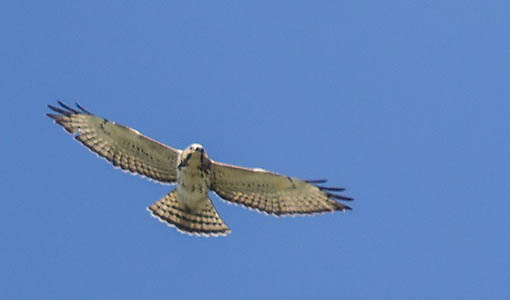 There
was also a fine flight of raptors this September. Five reports of young
Bald Eagles from Pt. Pinos to Monterey harbor to Jacks Peak was
extraordinary (even if some of them were the same individual moving
about). Three Swainson's Hawks around Jacks Peak in September, and
another well up Carmel Valley, were unexpected. Perhaps best of all,
there were 7 imm Broad-winged Hawks scattered from
Pacific Grove and Carmel to Jacks Peak between 23 Sep-1 Nov (photo
left, juv 23 Sep over P.G. cemetery © Blake Matheson). This small
eastern Buteo was once more regular in MTY as a rare
wintering species — and kettles of up to 17 Broad-wings appeared over
Pacific Grove on 2 Nov 1982 — so that this September movement brought
back recollections of the "glory years" in the past century. There
was also a fine flight of raptors this September. Five reports of young
Bald Eagles from Pt. Pinos to Monterey harbor to Jacks Peak was
extraordinary (even if some of them were the same individual moving
about). Three Swainson's Hawks around Jacks Peak in September, and
another well up Carmel Valley, were unexpected. Perhaps best of all,
there were 7 imm Broad-winged Hawks scattered from
Pacific Grove and Carmel to Jacks Peak between 23 Sep-1 Nov (photo
left, juv 23 Sep over P.G. cemetery © Blake Matheson). This small
eastern Buteo was once more regular in MTY as a rare
wintering species — and kettles of up to 17 Broad-wings appeared over
Pacific Grove on 2 Nov 1982 — so that this September movement brought
back recollections of the "glory years" in the past century. |
||||||||||
|
||||||||||
It's been a long time since there was a 'chaseable' Gray Catbird in MTY, so all the locals put on rubber boots to wade to see it. The last one at the Carmel River was back on 7-8 June 1997. That Catbird was discovered by — drum roll — Bill Hill. Long before digital cameras, MTY has been blessed with excellent photographers who documented local rarities. In the 1960s-1970s it was Ron Branson. In the 1980s, John Sorensen. And from about the 1990s, the go-to guy has been Bill Hill. Now with digital cameras we have several fine photographers, but Bill is a local lad who grew up to be the Carmel Fire Chief until retirement gave him more time to photograph birds. Two unexpected vireos also proved to be adults. Brian Sullivan found this scruffy Yellow-green Vireo (below left, photo 28 Aug © B.L. Sullivan) in Pacific Grove's "El Carmelo" cemetery on 28 Aug. We can tell it is an adult by the red eye. It was very elusive but was seen to 3 Sep. Carole Rose found this worn and beat-up Red-eyed Vireo — with its adult red eye — in Monterey's "San Carlos" cemetery on 5 Sep (photo below right © C. Rose). Yellow-green is the rarer of the two 'red-eyed' vireos in MTY, with just 11 records. We now average about 1-2 Red-eyed Vireos a year, and the species has attempted to summer at Big Sur River mouth. Remarkably, two vagrant hatch-year Red-eyed Vireos — with dark eyes — have already been one-day-wonders this fall. |
||||||||||
|
||||||||||
Michael Rieser found a more typical hatch-year Blackburnian at the Presidio of Monterey on 6 Sep. From a MTY perspective, these are the two earliest fall Blackburnians on record. Most of MTY's records are from October. Two small Spizella sparrows sparked discussion as well. On 6 Sep Paul Fenwick found this Brewer's Sparrow
at the Pacific Grove cemetery (below left, photo 6 Sep © D.
Roberson), and it remained to 7 Sep. There is only one earlier fall
record in MTY (5 Sep 1979 near Robinson Canyon, Rich Stallcup), and one
other from 7 Sep (in 2009 at Salinas WTP, Scott & Linda Terrill).
But it was not so much the early arrival that was curious. Birders
noted that at certain angles the extensive soft-gray half-collar of the
P.G. bird was more extensive than typical, and the face more patterned,
bringing to mind the possibility of "Timberline Sparrow." Described as
a separate species by Swath & Brooks in 1925, "Timberline Sparrow"
breeds in isolated populations at subalpine elevations in the Rockies
of s.e. Alaska to s.w. Alberta. It is currently considered a subspecies
of Brewer's Sparrow: S. b. taverneri. It apparently migrates
to the winter range of nominate Brewer's Sparrow, and there is said to
be a specimen from California (Rotenbery et al. 1999). Otherwise, there
is very little known about it. |
||||||||||
|
||||||||||
| There was also a run of other eastern warblers from the last days of August into early September: the earliest ever MTY Canada Warbler on 31 Aug at Big Sur R. mouth (photo below left © Paul Fenwick), several Chestnut-sided and Tennessee Warblers and American Redstarts, an adult Black-and-white Warbler, and a Northern Parula. Also, during the two week span between 28 Aug–9 Sep, about 21 Willow Flycatchers were found in MTY [including this hatch-year bird, below right, so beautifully captured by Brian Sullivan on 28 Aug at the P.G. cemetery, © B.L. Sullivan]. Up to 4 in a day were at Hot Spots like the P.G. cemetery (28 Aug), the Carmel River mouth (30 Aug), and the Big Sur River mouth (2 Sep). The most ever found in a single fall migration was 23 during autumn 1998. We already have 21 tallied in just two weeks . . .[Update: after the full date span of 26 Aug–25 Sep 2018, the best estimate was 33 Willow Flycatchers at 10 locations!]. | ||||||||||
|
||||||||||
| Tropical seabird! Meanwhile, offshore, a mix of warm water and other criteria suggest that an El Niño might be forming in the tropical Pacific. Whether it appears or not, Monterey Bay is starting to show more signs of changing time. On 1 September, while looking from Pt. Pinos with a new space-age scope, Blake Matheson watched and described a light-morph Wedge-tailed Shearwater fly past. There are just 3 MTY records for this tropical seabird, all more-or-less associated with El Niños. The first was also a light-morph bird on August 31, 1986, about 4 miles west of Pt. Pinos (Stallcup et al. 1998). | ||||||||||
On 24 August — the day before the Pt. Pinos Red-footed Booby — a larger and more controversial booby was a few miles west of Pt. Pinos, found from a Shearwater Journeys pelagic trip (both photos below © Alex Lamoreaux; in the upper photo the booby is harassed by an imm Heermann's Gull). It is clearly a young booby just beginning post-juvenal wing molt (at innermost primary) and undergoing body molt on the head, neck, and upperwing coverts. |
||||||||||
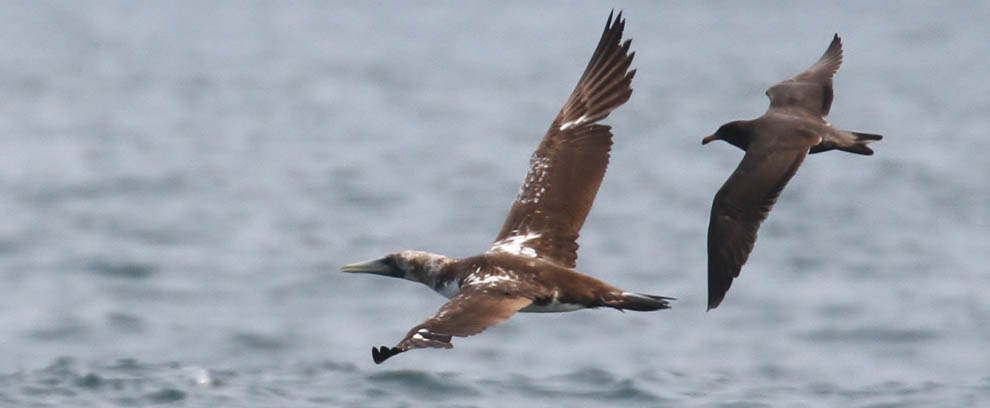 |
||||||||||
Note that only the distal half of the bill is yellow (and a small stripe along the cutting edge), but the basal half is essentially bone-white. A half-yellow bill is just fine for Nazca — it is the color at the base of the bill that separates Masked from Nazca. The state of molt of this booby suggests it is about a year old. Some observers now think that perhaps only Nazca Booby can have a chalky-white base to the bill a year after it is hatched — perhaps Masked Booby should have a more completely yellow or yellow-green bill by this age. More study is needed. |
||||||||||
|
||||||||||
| Summer
2018, at least along the coast, was cold and foggy much of the time,
while interior temperatures were scorching. Few vagrants occurred
during summer, except some fine seabirds (below); an exception was a
Brown Thrasher briefly in a Pacific Grove yard on 23 June (Blake T.
Matheson). By mid-August, though, a few interesting landbird migrants
appeared on the Monterey Peninsula. Carole Rose found both of these: an
imm male Costa's Hummingbird in her yard in the Skyline Forest area of Monterey (below left, photo 17 Aug © Carole Rose) and a Tennessee Warbler in Pacific Grove's El Carmelo cemetery (below right, photo 16 Aug © C. Rose; with an Orange-crowned Warbler). Costa's Hummingbirds breed locally in southern MTY but are quite rare on the Monterey Peninsula. This one first appeared in the Roses' yard on 4 Aug, The young male has been molting in its violet gorget since then as he defends a small patch of planted Mexican sage. The Tennessee Warbler record is unusual in several ways. First, it is remarkable that Carole got both the Tennessee and and an Orange-crowned Warbler in the same photo. The photo illustrates some of the important structural differences between these two warblers: Tennessee is smaller, much shorter-tailed but longer-winged, and much shorter-billed than Orange-crowned. These differences are more important on imm Tennessee Warblers which are yellow below (but for white undertail coverts). This August's Tennessee was an adult (probably a female), and that is also unusual. Most vagrant Tennessees are hatch-year birds later in fall migration. Did this adult Tennessee summer locally? Or is it a very early migrant? There are only two prior records in summer, both at Big Sur R. mouth: 16 July 1998 (Jim Booker) and 22 Aug 2015 (Alex Rinkert). |
||||||||||
|
||||||||||
This summer, a fresh juv was near Jacks Peak on 30 July (Blake Matheson), suggesting breeding nearby. On 31 July, a bright imm visited a backyard in Pacific Grove (Rita Carratello). Two more very early migrants were seen in Pacific Grove on 14-15 Aug (Gary Dial, Bruce Mast). There are a few other migrant records in August (see Monterey Birds, 2d ed.) but the Pt. Pinos bird brings our summer total to 5 Hermits, which is indeed unusual. |
||||||||||
The summer's biggest news involved boobies from tropical seas. The first was a subadult Nazca Booby seen initially on Monterey Bay on 24 June by Don Bacchus, Jim Scarff, and Kate Spencer from FastRaft. This same individual was seen and photographed again on 26 June from Discovery Whale Watch
(photo below 26 June © Eric Austin Yee). There are now 6 records
in MTY. Nazca Booby is primarily a bird of the Galapagos Islands and
all of California's records have occurred during this century. There
have been multiple Nazca Boobies in southern CA waters this past spring
and summer. Given this sea-change in distribution, one might think that
some sort of warming trend in the global climate might be underway. |
||||||||||
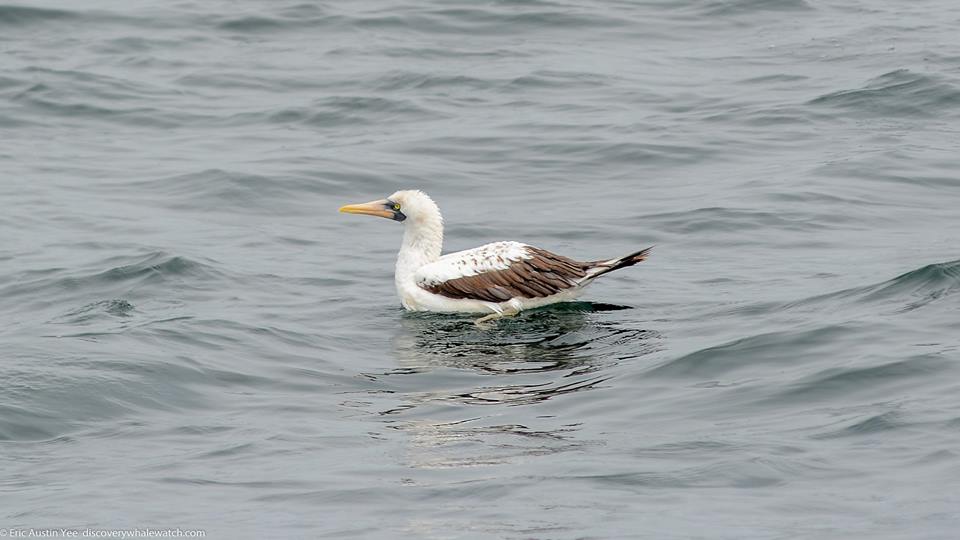 |
||||||||||
In California — and before Nazca was split from Masked Booby as a species — Red-footed was the rarest of all State boobies. Until recently, except for an incursion in fall 1987, there had never been more than 1-2 in any year. From Aug-Dec 1987 at least six reached California, four of which were in central California). MTY's first records were in that incursion. During 2017 & 2018 so far, at least a half-dozen Red-footed Boobies have been seen on-shore or offshore in southern California. But the most visited by birders was one at Pillar Point Harbor in San Mateo County from 29 Oct-13 Dec 2017. July's specimen from Moss Landing added another. |
||||||||||
Then, on Sunday afternoon 12 August, Kate Cummings of Blue Ocean Whale Watch was heading out of Moss Landing harbor aboard "High Spirits" when she spotted this Red-footed Booby riding on the bow of the fishing boat "Fishore," which was heading into the harbor (photo below 12 Aug © Kate Cummings). It had presumably landed on that boat somewhere in Monterey Bay that day. |
||||||||||
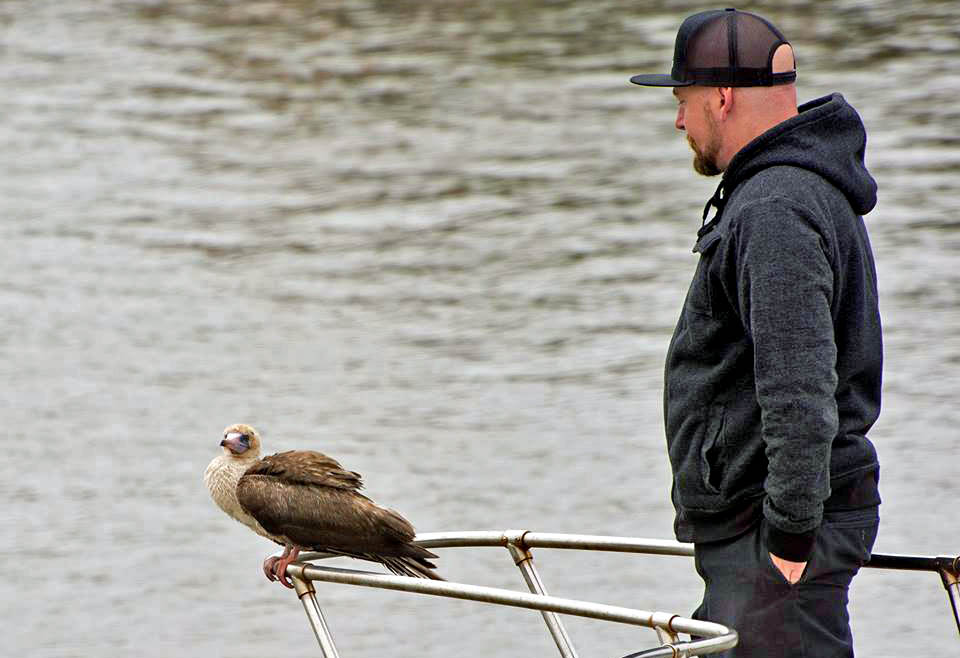 |
||||||||||
When the Blue Ocean whale watch returned to the harbor at 5 p.m., Kate Cummings spotted the booby roosting on a sailboat moored in Moss Landing marina. It was still there on Monday morning when seen by many local birders (photo left 13 Aug © D. Roberson). It was apparent that this subadult Red-footed Booby was either very tired or was ill. At mid-day it fell from the mast to the deck of the sailboat. Monterey SPCA was called and they took it to their Wildlife Rescue Center. Tests showed it was emaciated with no protein in its blood. Despite giving it food and meds, the booby died overnight (fide Corey Utter). Both of MTY's Red-footed Boobies from this summer will be necropsied by California Fish & Game to determine the cause of death. It has been arranged that both will likely become specimens in a major California museum (fide Steve Hampton). California has at least two prior specimens in museums, "both are relatively small and dark, consistent with Red-footed Booby populations in the eastern Pacific" (CBRC 2007). |
||||||||||
Literature cited:
|
||||||||||
|
|
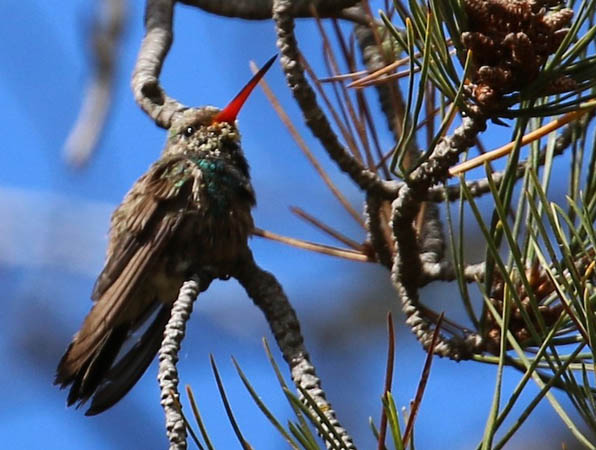 In
an autumn full of surprises, one of the most unexpected was documented
by a visitor from New York State during a field trip, looking for
condors, offered by the annual Monterey Bay Bird Festival in
Watsonville. At a stop at Grimes Point on the Big Sur coast on 29 Sep,
Suzanne O'Rourke wandered over to some blooming Salvia and snapped this photograph of a young male Broad-billed Hummingbird!
(photo left 29 Sep © Suzanne O'Rourke). By the time the rest of
the birders on the trip got to the spot, the hummer had vanished and
was never seen again.
In
an autumn full of surprises, one of the most unexpected was documented
by a visitor from New York State during a field trip, looking for
condors, offered by the annual Monterey Bay Bird Festival in
Watsonville. At a stop at Grimes Point on the Big Sur coast on 29 Sep,
Suzanne O'Rourke wandered over to some blooming Salvia and snapped this photograph of a young male Broad-billed Hummingbird!
(photo left 29 Sep © Suzanne O'Rourke). By the time the rest of
the birders on the trip got to the spot, the hummer had vanished and
was never seen again.  Birders were luckier with another rarity in late September — this young female Bay-breasted Warbler
at Pt. Pinos, found by Blake Matheson on 22 Sep, that lingered through
26 Sep and was photographed by many (photo right 23 Sep © Bill
Hill). Note the lime-green crown and back and the black legs and feet
that help separate it from hatch-year Blackpoll Warblers.
Birders were luckier with another rarity in late September — this young female Bay-breasted Warbler
at Pt. Pinos, found by Blake Matheson on 22 Sep, that lingered through
26 Sep and was photographed by many (photo right 23 Sep © Bill
Hill). Note the lime-green crown and back and the black legs and feet
that help separate it from hatch-year Blackpoll Warblers. 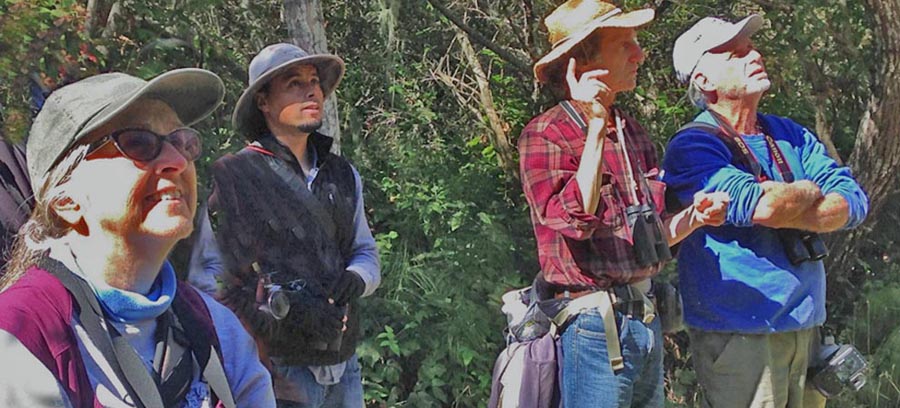
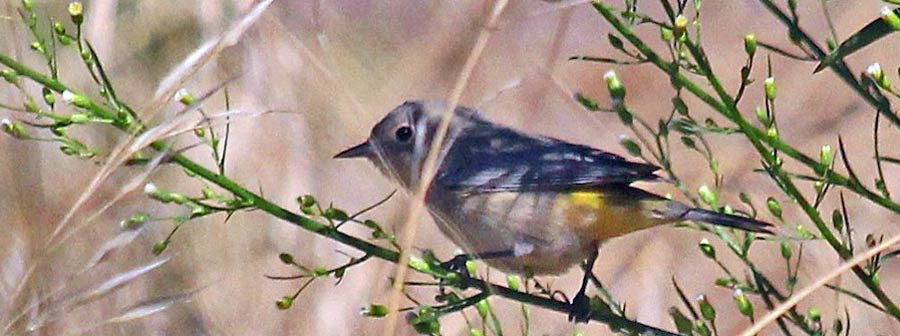
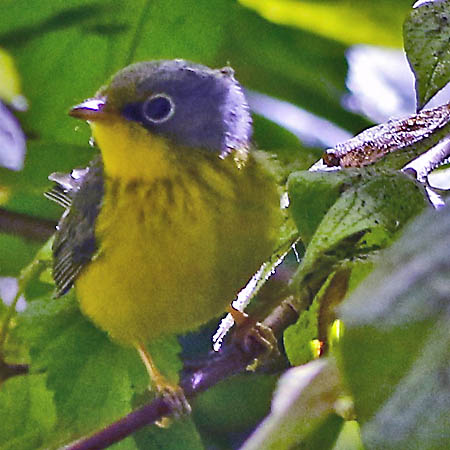
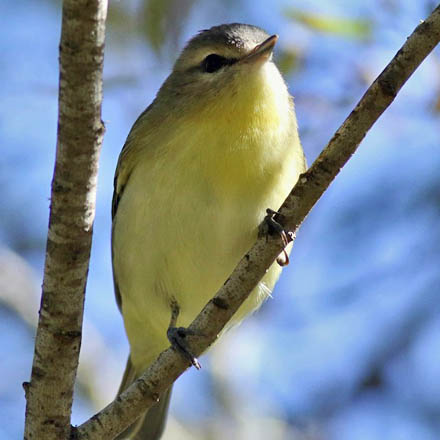



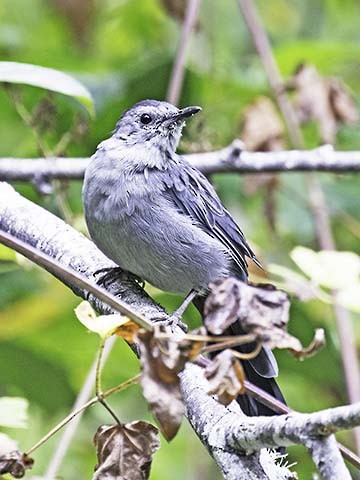 Autumn
rarities started early in 2018. Surprisingly, they began with a run of
adult vagrant passerines — this is a surprise because more than 90% of
fall vagrants are hatch-year birds in their first migration. The best
was a Gray Catbird discovered by the remarkable Bill
Hill on 28 August (photo right 28 Aug © Bill Hill). It took up
residence in a riparian thicket, eating creek dogwood berries and
occasionally singing or giving its 'mew' call. You can see from Bill's
photo that an outer rectrix is growing in on 28 Aug. When we saw it on
9 Sep, the tail seemed complete. It seems this bird was present to molt
before moving south. Did it summer here? Or is this an example of "molt
migration" — adults moving away from the breeding locale to another
spot to molt before migrating, something that is documented in eastern
passerines and is currently being studied (fide Scott Terrill).
Autumn
rarities started early in 2018. Surprisingly, they began with a run of
adult vagrant passerines — this is a surprise because more than 90% of
fall vagrants are hatch-year birds in their first migration. The best
was a Gray Catbird discovered by the remarkable Bill
Hill on 28 August (photo right 28 Aug © Bill Hill). It took up
residence in a riparian thicket, eating creek dogwood berries and
occasionally singing or giving its 'mew' call. You can see from Bill's
photo that an outer rectrix is growing in on 28 Aug. When we saw it on
9 Sep, the tail seemed complete. It seems this bird was present to molt
before moving south. Did it summer here? Or is this an example of "molt
migration" — adults moving away from the breeding locale to another
spot to molt before migrating, something that is documented in eastern
passerines and is currently being studied (fide Scott Terrill). 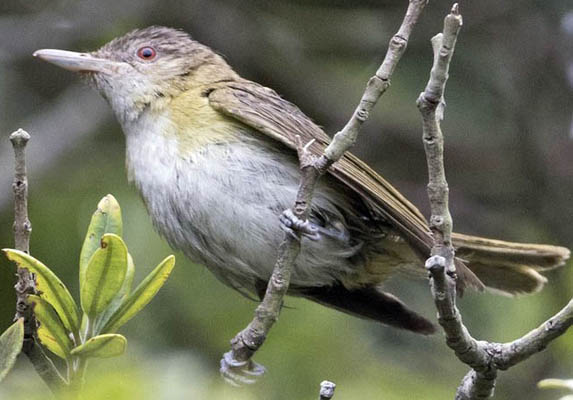
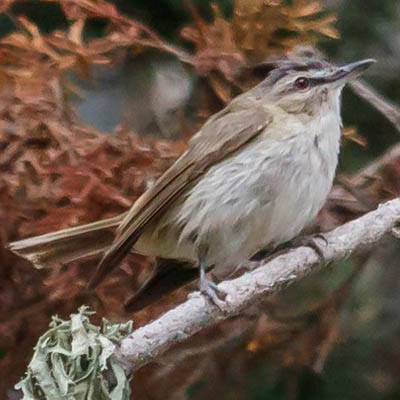
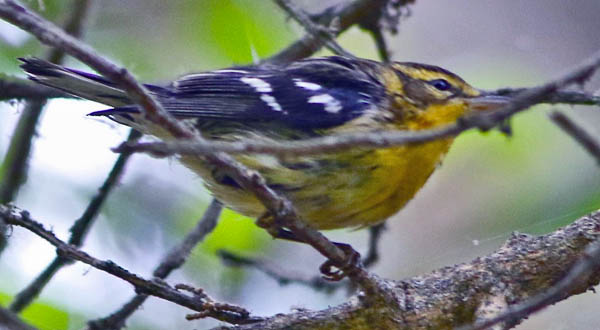 Another potential adult vagrant was this Blackburnian Warbler,
found by Rick Fournier at Pt. Pinos on 5-6 Sep (photo right 5 Sep
© D. Roberson). Rick thought it was a worn adult female, and
details of the amount and shape of the white tips that create the two
wingbars further support the theory (per Pyle's 1997 banding guide).
Another potential adult vagrant was this Blackburnian Warbler,
found by Rick Fournier at Pt. Pinos on 5-6 Sep (photo right 5 Sep
© D. Roberson). Rick thought it was a worn adult female, and
details of the amount and shape of the white tips that create the two
wingbars further support the theory (per Pyle's 1997 banding guide). 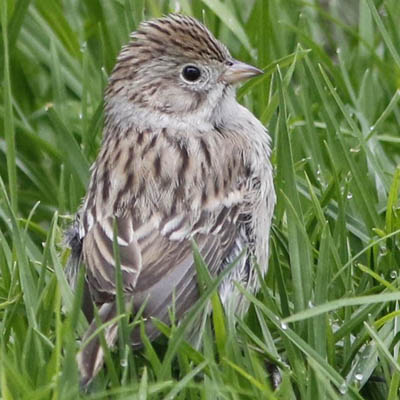

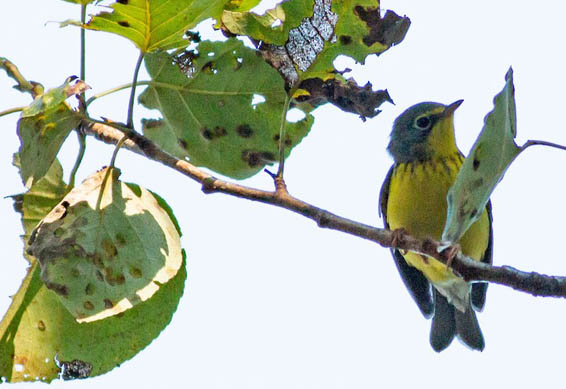
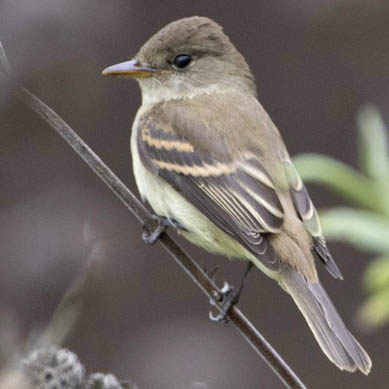
 More tropical boobies!
Farther down this page you'll find that the top highlights of summer
2018 were tropical boobies usually limited to warmer seas in the
eastern tropical Pacific. Two more were headlines in August. On 25
August, Brian Sullivan watched this immature dark-morph Red-footed Booby
fly past Pt. Pinos while Brian was sea-watching — and he even managed a
few photos! (photo right © B.L. Sullivan). This is just the 5th
record for MTY.
More tropical boobies!
Farther down this page you'll find that the top highlights of summer
2018 were tropical boobies usually limited to warmer seas in the
eastern tropical Pacific. Two more were headlines in August. On 25
August, Brian Sullivan watched this immature dark-morph Red-footed Booby
fly past Pt. Pinos while Brian was sea-watching — and he even managed a
few photos! (photo right © B.L. Sullivan). This is just the 5th
record for MTY. 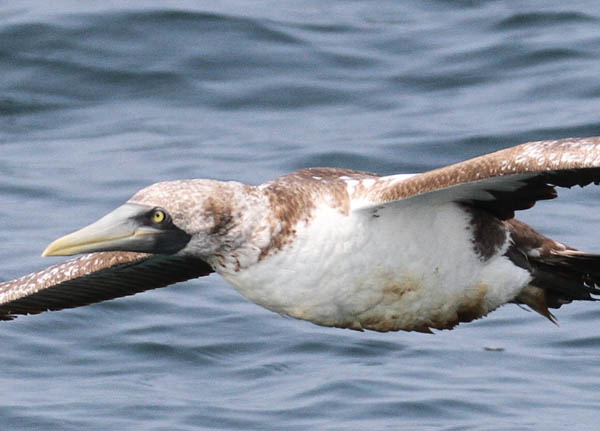 Some have labeled it "Masked Booby," largely on bill color, but the more recent trend in analysis leans towards Nazca Booby
(as does this commentator). As you see down the page, there are 6
recent records of Nazca in MTY — and an amazing influx off southern
California.
Some have labeled it "Masked Booby," largely on bill color, but the more recent trend in analysis leans towards Nazca Booby
(as does this commentator). As you see down the page, there are 6
recent records of Nazca in MTY — and an amazing influx off southern
California.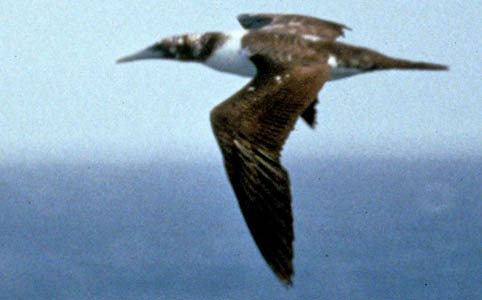
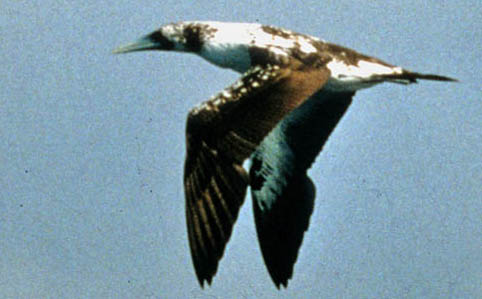
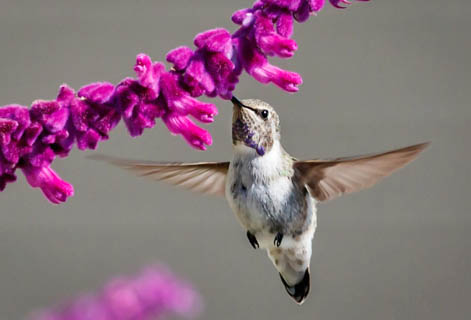

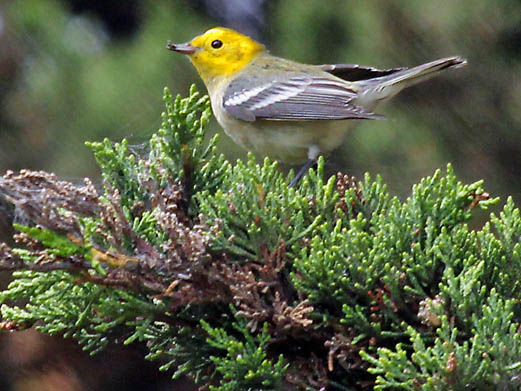 Carole and Larry Rose also found this female Hermit Warbler
at Pt. Pinos on 17 Aug (photo left © Rita Carratello; the warbler
has captured a bug), but it was a part of a larger phenomena involving
this species. Hermit Warbler winters here in MTY regularly in small
numbers, and is a scarce spring and fall migrant. The nearest known
breeders are in the Santa Cruz Mountains. However, singing males have
been present in Ponderosa pine habitat in late May and June in the
Santa Lucia Mountains, and during the Breeding Bird Atlas, a fresh juv
was observed on Anderson Peak above Big Sur (17 July 1992, D. Roberson,
R. Carratello). This strongly suggests that some local nesting occurs.
Carole and Larry Rose also found this female Hermit Warbler
at Pt. Pinos on 17 Aug (photo left © Rita Carratello; the warbler
has captured a bug), but it was a part of a larger phenomena involving
this species. Hermit Warbler winters here in MTY regularly in small
numbers, and is a scarce spring and fall migrant. The nearest known
breeders are in the Santa Cruz Mountains. However, singing males have
been present in Ponderosa pine habitat in late May and June in the
Santa Lucia Mountains, and during the Breeding Bird Atlas, a fresh juv
was observed on Anderson Peak above Big Sur (17 July 1992, D. Roberson,
R. Carratello). This strongly suggests that some local nesting occurs. 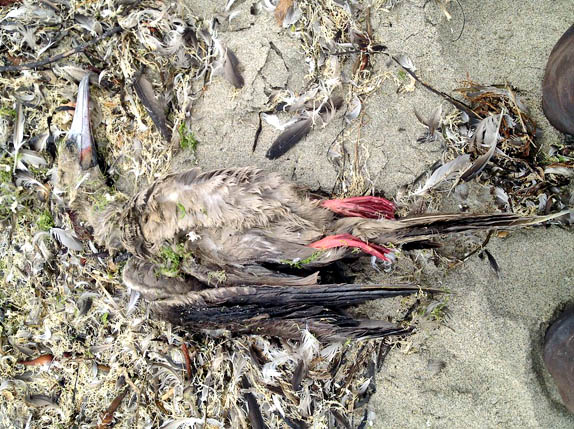 More unexpected was the presence of two subadult Red-footed Boobies
in MTY this summer. The first was found dead, washed up on Moss Landing
SB, on 1 July (photo right © Ryan Carle). It appeared to be
emaciated and perhaps died of starvation. In tropical seas, Red-footed
Boobies forage far offshore — often chasing and catching flying fish —
but perhaps there is not enough surface fish in Monterey Bay to support
their foraging strategy? Red-foots are also notorious for their habitat
of resting and sleeping on anything that is floating on the sea:
flotsam, kelp, sea turtles (dead or alive), and (most often) ships.
When I spent 4 months at sea as a NOAA naturalist, one Red-footed Booby
rode on our research ship for 5 days and hundreds of miles, sleeping on
the mast each night, until we could see Hawaii in the distance.
More unexpected was the presence of two subadult Red-footed Boobies
in MTY this summer. The first was found dead, washed up on Moss Landing
SB, on 1 July (photo right © Ryan Carle). It appeared to be
emaciated and perhaps died of starvation. In tropical seas, Red-footed
Boobies forage far offshore — often chasing and catching flying fish —
but perhaps there is not enough surface fish in Monterey Bay to support
their foraging strategy? Red-foots are also notorious for their habitat
of resting and sleeping on anything that is floating on the sea:
flotsam, kelp, sea turtles (dead or alive), and (most often) ships.
When I spent 4 months at sea as a NOAA naturalist, one Red-footed Booby
rode on our research ship for 5 days and hundreds of miles, sleeping on
the mast each night, until we could see Hawaii in the distance.